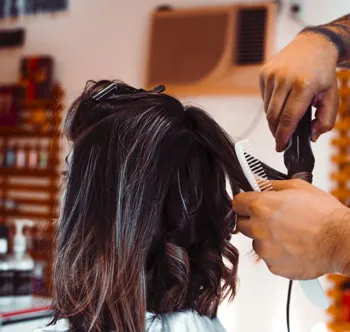
Hair Disasters - How To Prevent
 I was recently reading about some DIY Hair Disasters and the high price of having them repaired by the pros. The article quoted the National Cosmetology Association Executive Director Gordon Miller who said that business was down at 72 percent of all hair salons surveyed last summer (2008) and that customers are "stretching out" their visits.
I was recently reading about some DIY Hair Disasters and the high price of having them repaired by the pros. The article quoted the National Cosmetology Association Executive Director Gordon Miller who said that business was down at 72 percent of all hair salons surveyed last summer (2008) and that customers are "stretching out" their visits.
(Image courtesy of Eric Von Lockhart - all fights reserved).
The same article quoted a Sally Beauty spokesperson who confirmed that consumers were buying more DIY hair color and related products.
None of this DIY Disaster information surprises me since even in great economic times DIY Hair Disasters are an experience that many people live through at some point in their lifetimes.
I have had my own hair disasters but my most recent one came at the hands of a professional hair dresser named Lorrie who is a booth renter in the Coit and Spring Creek area.
Even more upsetting about my hair color disaster, besides the fact it was created by a hairdresser, was the reality she didn't call me back for days after my frantic "my head is on fire" messages (the dye burned my scalp). Even more upsetting? She didn't offer to fix the hair color disaster, she created, at her time and expense.
Luckily for me, my many friends in the professional hair care market helped me through the disaster and my hair recovered without any long term damage.
Hair Disasters can occur in the form of:
1. Do It Yourself (DIY)
2. At the hands of a professional hair care providerWith some planning most people can prevent both types of hair disasters from occuring. At the very least they can minimize the trauma.
DIY Hair Disasters
 1. Understand your risks - if you've never colored, cut or chemically altered your hair before, you will have a higher risk of problems then if you've already successfully gone through the process. Think carefully of the possible risks before you proceed.
1. Understand your risks - if you've never colored, cut or chemically altered your hair before, you will have a higher risk of problems then if you've already successfully gone through the process. Think carefully of the possible risks before you proceed.
If you decide to move forward, try to do the treatments during a day and time when help is available if you have a problem.
(Image courtesy of Eric Von Lockhart - all fights reserved).
So many hair consumers take on new DIY hair treatments in the middle of the night or on weekends when professional help is not readily or easily available.
2. Get as much advance help as possible - if you're a newbie be sure to gather as much information as possible before you start. There is tons of information about hair care treatments on the Web or in books and magazines. Read and research before you begin your DIY journey.
If you explain to your regular hair colorist that money is tight, they may be willing to sell you a small amount of touch up color for your roots for in-between visits. Or they may help you slightly alter your color to prevent the need for constant touch-up.
3. Go slow - if you're going to color your hair, only color a small hidden section first to test the outcome. If all goes well, you can always go back and color your entire head. Consider buying a product from a company known for their help such as Clairol who offers toll free product assistance.
Or ask in advance what type of correction service might be available if you encounter a problem. Most companies will not guarantee assistance but many will do their best to help.
 4. Go to a Cosmo School, be a hair model or barter - I went to Paul Mitchell Cosmetology school and the students were constantly supervised The teachers were all exceptionally experienced and I had them do my hair at the school with great results. I can't speak highly enough about the Paul Mitchell schools for the students and the hair consumers who visit for services.
4. Go to a Cosmo School, be a hair model or barter - I went to Paul Mitchell Cosmetology school and the students were constantly supervised The teachers were all exceptionally experienced and I had them do my hair at the school with great results. I can't speak highly enough about the Paul Mitchell schools for the students and the hair consumers who visit for services.
(Image courtesy of Eric Von Lockhart - all fights reserved).
Being a hair model at a salon that has an apprentice program is risky because you can't control the type of cut and/or color, but at least you are getting your hair professionally serviced. You might also make the appropriate contacts to save on future services at that salon.
If you are really in financial need why not stop in a salon and offer to do some work in exchange for a haircut. Can you answer the phones or sweep the floors or run errands? Or consider going with a Cut-In-The-Box salon which offers the very lowest prices.
Professional Hair Disasters
Although it's not common, professional hair disasters can happen. While you may not be able to completely prevent them from occurring, you can minimize your risk with the following preventive measures:
1. Always get referrals for a new hairdresser or salon from friends, family or the local Better Business Bureau. If you go to a new hair professional, be sure they stand behind their work if something goes wrong.
 2. Hairdressers are people. They have bad days just like everyone else. Try to schedule your appointment on the least busy days and times when your hairdresser will be less pressured or rushed. Mistakes happen most often when a hairdressers is super busy and may not be able to pay as close attention to your hair.
2. Hairdressers are people. They have bad days just like everyone else. Try to schedule your appointment on the least busy days and times when your hairdresser will be less pressured or rushed. Mistakes happen most often when a hairdressers is super busy and may not be able to pay as close attention to your hair.
That's what happened with my hair color disaster. My hairdresser was running behind schedule and wasn't paying attention to the formula that needed to be applied to my hair. As a result she applied the wrong chemicals which burnt my scalp and turned my hair orange.
(Image courtesy of Eric Von Lockhart - all fights reserved).
3. Pay by credit card or check. If problem does occur and your hairdresser is unwilling or unable to fix the problem or is unwilling to refund your money, you have an option to ask the Credit Care Company or bank to investigate getting your money back. Of course you should never do a charge back or cancel a payment unless all means of working out the problem are first exhausted with the hairdresser or their salon but it gives you a safety net just in case.
4. Pay attention, ask questions, be proactive - When working with any hairdresser it is the hair consumers responsibility to make sure they communicate their wants and desires. Take photos of the hair style you wish to have created, the hair cut you like or the hair color you are going for.
Keep in mind that hairdressers are not miracle workers and sometimes the images your present are not possible to be recreated. A good hairdresser will tell you what they can or can't do based on your original request. Listen, ask questions and be willing to leave the salon without services if you are not comfortable with the answers your hear.
When Any Type Of Hair Disaster Occurs
 When a hair disaster occurs the most important action is to be calm. The worst reaction is to overact or take immediate action. Take a deep breath and completely access the situation. Once you are calm, call for assistance from a friend or family member who can help you remain clear as you look for the best solution to the problem.
When a hair disaster occurs the most important action is to be calm. The worst reaction is to overact or take immediate action. Take a deep breath and completely access the situation. Once you are calm, call for assistance from a friend or family member who can help you remain clear as you look for the best solution to the problem.
(Image courtesy of Eric Von Lockhart - all fights reserved).
If the hair disaster was the result of your own DIY actions, call the toll free help line on the box of hair color or get in your car and drive to the beauty supply location where you purchased the chemicals and ask for their help. You may also wish to call the local Cosmo school and ask if you can come in for a correction treatment.
If the damage is the result of a visit to a hair professional, it is also important to be very calm. Yelling at the hairdresser or the salon will only make matters worse. You may also wish to secure the help of a good friend or family member to speak on your behalf.
When dealing with a professional hair disaster it is very important to call as soon as possible. The longer you wait to report the problem, the less responsible most hairdresses will become due to a variety of factors.Social Media Network Information
Please follow us on Twitter at: https://Twitter.com/HairBoutique. I look forward to meeting new people from all walks of Twitter and learning from their Tweets.















